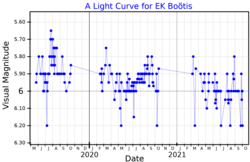
15 Andromedae, abbreviated 15 And, is a single, variable star in the northern constellation of Andromeda. 15 Andromedae is the Flamsteed designation, while its variable star designation is V340 And. Its apparent visual magnitude is 5.55, which indicates it is faintly visible to the naked eye. Its estimated distance from the Earth is 252 light years, and it is moving further away with a heliocentric radial velocity of 13 km/s.

Theta Boötis, Latinized from θ Boötis, is a star in the northern constellation of Boötes the herdsman, forming a corner of the upraised left hand of this asterism. It has the traditional name Asellus Primus and the Flamsteed designation 23 Boötis. Faintly visible to the naked eye, this star has a yellow-white hue with an apparent visual magnitude of 4.05. It is located at a distance of 47.2 light years from the Sun based on parallax, but is drifting closer with a radial velocity of −10.6 km/s.
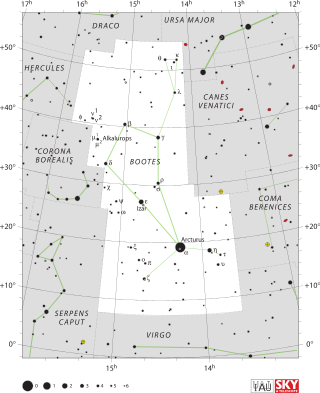
Kappa Boötis is a double star in the constellation Boötes. It has the traditional name Asellus Tertius and the Flamsteed designation 17 Boötis. The components are separated by an angular distance of 13.5 arcsec, viewable in a small telescope. Kappa Boötis is approximately 155 light years from Earth.
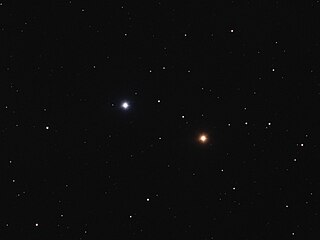
Nu1 Boötis (ν1 Boötis) is an orange-hued star in the northern constellation of Boötes. It has an apparent visual magnitude of +5.02, which indicates the star is faintly visible to the naked eye. Based upon an annual parallax shift of 3.35 mas as seen from Earth, it is located roughly 970 light years distant from the Sun. At that distance, the visual magnitude of the star is diminished by an extinction of 0.13 due to interstellar dust.

Rho Boötis, Latinised from ρ Boötis, is a single, orange-hued star in the northern constellation of Boötes. It is visible to the naked eye with an apparent visual magnitude of 3.59. Based upon parallax measurements, it is located at a distance of approximately 160 light-years from Earth. It is moving toward the Sun with a radial velocity of −13.6 km/s. There is an optical companion, a magnitude 11.5 star, located 34.7 arcseconds away along a position angle of 345°.

2 Centauri is a single star in the southern constellation of Centaurus, located approximately 183 light-years from Earth. It has the Bayer designation g Centauri; 2 Centauri is the Flamsteed designation. This object is visible to the naked eye as faint, red-hued star with an apparent visual magnitude of 4.19. It is moving away from the Earth with a heliocentric radial velocity of +41 km/s. The star is a member of the HR 1614 supercluster.

HR 5553 is a binary star system located thirty-eight light-years away from the Sun, in the northern constellation Boötes. It has the variable star designation DE Boötis, and is classified as an RS Canum Venaticorum variable that ranges in apparent visual magnitude from 5.97 down to 6.04, which is bright enough to be dimly visible to the naked eye. The system is drifting closer to the Sun with a radial velocity of −30 km/s, and is expected to come as close as 26.9 light-years in 210,000 years.
HD 125351 or A Boötis is spectroscopic binary in the constellation Boötes. The system has an apparent magnitude of +4.97, with a spectrum matching a K-type giant star. It is approximately 233 light-years from Earth.

OU Andromedae is a rotationally variable star in the constellation Andromeda. Varying between magnitudes 5.87 and 5.94, it has been classified as an FK Comae Berenices variable, but the classification is still uncertain. It has a spectral classification of G1IIIe, meaning that it is a giant star that shows emission lines in its spectrum. It is also likely in its horizontal branch phase of evolution.

Rho2 Arietis is an M-type red giant star in the northern constellation of Aries. Its brightness varies from magnitude 5.45 to 6.01, making it faintly visible to the naked eye under good observing conditions. With an annual parallax shift of 9.28 mas, it is approximately 350 light-years distant from the Earth.

IQ Aurigae is a single, variable star in the northern constellation of Auriga. It is visible to the naked eye as a dim, white-hued star with an apparent visual magnitude that fluctuates around 5.38. The star is located at a distance of about 460 light-years from the Sun based on parallax and is drifting further away with a radial velocity of +28.6 km/s.
HD 36678 is single star in the northern constellation of Auriga. This star is dimly visible to the naked eye with an apparent visual magnitude of 5.83. It is located at a distance of approximately 840 light years from the Sun based on parallax.
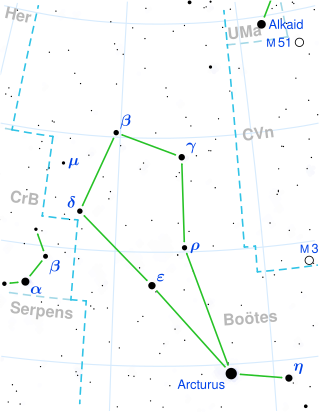
HD 123657, or BY Boötis, is a variable star of magnitude 4.98–5.33V. This makes it a dim naked eye star. The star is located near the end of the handle of the Big Dipper, but just within the boundaries of the constellation Boötes.

HD 128333 or CH Boötis is an irregular variable star in the northern constellation of Boötes. With an apparent magnitude of 5.7, it is faintly visibly to the naked eye under good observing conditions.

HD 135530 is a suspected variable star in the northern constellation of Boötes.
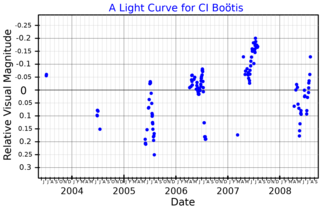
HD 126009 or CI Boötis is a variable star in the northern constellation of Boötes. With an apparent magnitude of 6.6, it would be extremely difficult to see with the naked eye even under the very best observing conditions, but can easily be seen with binoculars.

R Boötis is a variable star in the northern constellation of Boötes. The star's brightness varies tremendously, ranging from apparent magnitude 6.0, when it might be faintly visible to the naked eye under very good observing conditions, to 13.3, when a fairly large telescope would be required to see it. The distance to this star is approximately 2,150 light years based on parallax measurements. It is drifting closer with a radial velocity of about −58 km/s.

HD 93194 is a star in the constellation Carina. Its apparent magnitude is 4.79. Its parent cluster is IC 2602.

HD 93607 is a star in the constellation Carina. Its apparent magnitude is 4.87. Its parent cluster is IC 2602.
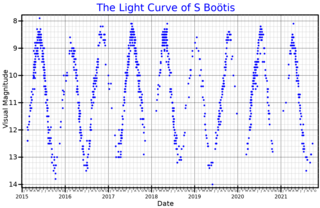
S Boötis is a Mira variable in the constellation Boötes. It ranges between magnitudes 7.8 and 13.8 over a period of approximately 270 days. It is too faint to be seen with the naked eye, however when it is near maximum brightness it can be seen with binoculars.
